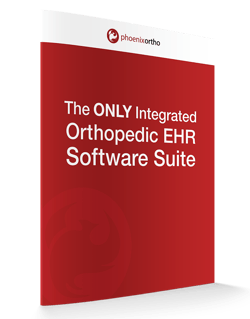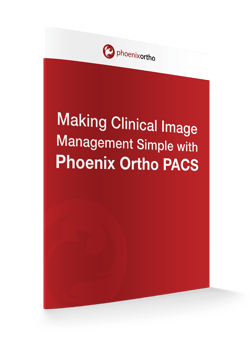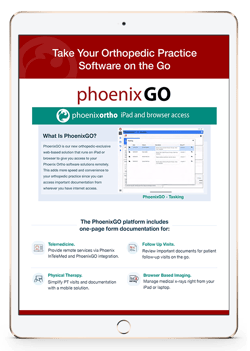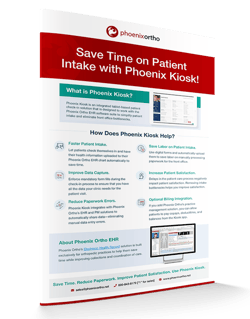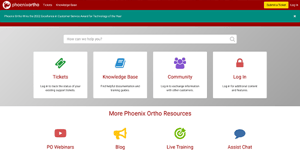Orthopedic clinics have to keep track of many different rules and regulations. One such rule is the Global Period for post-op treatments. Global Period visits represent pure costs for orthopedic physicians since there is no revenue to be gained. It’s free care for the patient.
Minimizing the costs of Global Period visits is crucial for orthopedic clinics. Spending too much time and money on these post-op processes can drain a clinic’s resources. It also limits the time and resources that can be applied to the needs of other patients.
However, there’s a better way to handle these pure cost, zero revenue patient visits: using a telemedicine/telehealth solution. With telemedicine solutions like Phoenix InTeleMed, health care providers can minimize their post-op visit costs with remote visits—while still providing top-quality care and convenience that promotes repeat visits.
Phoenix InTeleMed and Global Period Visits
How does a telehealth solution help orthopedic clinics with post-op patient care? There are several key benefits for using a telemedicine solution like Phoenix InTeleMed when it comes to conducting post-op visits:
- Saving Time. The big benefit of conducting patient visits remotely is that it saves time. Orthopedic doctors can review images and treatment details sent by a patient over the phone to prep for a conversation before it begins—helping to speed up the visit. Patients save time too since they don't have to wait in a room. Instead, they can get on with their day until the doctor is ready to “see” them.
- Reaching More Patients. Remote visits remove the need for patients to physically travel to an orthopedic clinic for basic consultations. This eliminates one of the biggest barriers to seeing new patients—allowing more patients to “visit” orthopedists.
- Making It Easier to Bill for Visits Not Covered by the Global Period. Not every visit that happens after an operation will be covered by the Global Period rule. Using a telehealth solution alongside an EHR software that can track Global Period timelines and verify current procedural terminology (CPT) codes to determine if a visit is or isn’t billable can help orthopedic surgeons recover some value from visits that might otherwise have accidentally been given away as part of the post-op treatment regimen.
In fact, Phoenix Ortho is working on refining its telehealth solution to make remote patient visits more efficient—saving even more time, money, and effort for orthopedic physicians.
With remote visits, orthopedic doctors can make a positive impact on patient health while increasing convenience, saving time, and improving their clinic’s cash flow.
What about HIPAA and 3rd Party Health Waivers?
Currently, many in the healthcare industry are already using telemedicine technologies to provide remote visits to their patients. A common question they have is “Why should we use Phoenix InTeleMed when I already have a telehealth system?”
The issue is that many of the telemedicine solutions clinics are using are completely third-party. They use an interface that sends data to a third-party vendor to store, transmit, and/or process on the behalf of an EHR/EMR company. This is a technical violation of the Health Insurance Portability and Accountability Act (HIPAA), as it releases personal health information (PHI) to a third party.
However, in response to the COVID-19 outbreak, the Department of Health & Human Services (HHS) issued a temporary waiver of “sanctions and penalties against a covered hospital that does not comply with the… HIPAA Privacy Rule.” It’s important to note that this waiver is only temporary. Once the crisis passes, things will go back to “business as usual.” This means that clinics using third-party telemedicine solutions that aren’t fully integrated and send data out to a separate company may get hit with fines and other penalties under the HIPAA Privacy Rule.
Phoenix InTeleMed averts this issue by being a fully-integrated telehealth solution—the data lives in Phoenix Ortho’s EHR system, and does not go out to a third party. Even with the optional video function (Backline, powered by DrFirst), PHI is kept between doctors and patients.
The Benefits of Having Video Remote Visits with Patients
Sometimes, patients need more than just a phone call. There are times where an orthopedic physician needs to have face-to-face time to run patients through a few tests and examinations, or see patient reactions in real-time. Video remote visits help orthopedists with this.
Phoenix InTeleMed has an optional video function called Backline (which is powered by a partnership with DrFirst). While Phoenix InTeleMed is free for all Phoenix Ortho EHR users, Backline does have a small additional cost. However, it’s well worth it because it helps:
- Improve Remote Visit Diagnoses. With video, an orthopedic physician can see a patient’s symptoms, including how injuries limit range of motion, discoloration of the skin near the injury site during motion, and the patient’s general body language. This can help to make remote visit diagnoses more accurate.
- Increase Patient Satisfaction. Video visits help make the whole process feel more personal and attentive than a phone call alone. This helps to increase the patient’s satisfaction with the visit—increasing the likelihood of future visits (and thus, collections).
These are just a small sample of the benefits of using video for remote visits with patients. Need to add telehealth to your orthopedic clinic’s workflow? Reach out to Phoenix Ortho to get started!

Schedule a 1:1
Get in touch with Phoenix Ortho to learn more about how you can save time, money, and mouse clicks with an orthopedic-specific EHR.





